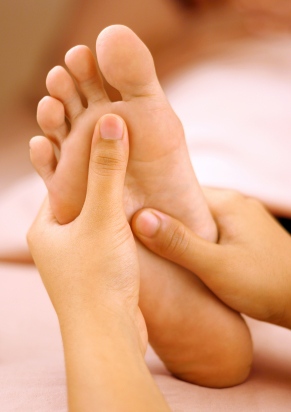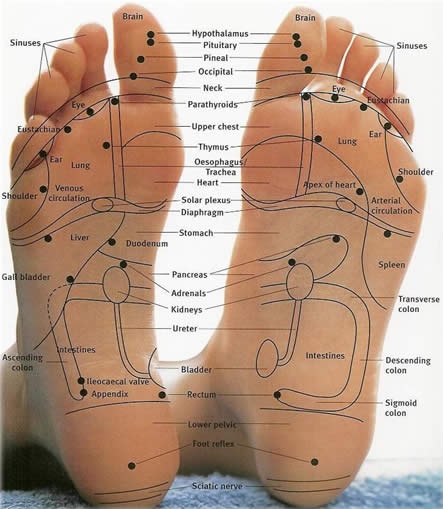What is Reflexology?

Reflexology is a natural healing technique based on the principle that there are reflexes in the hands, feet and ears that correspond to every part, organ and gland of the body. Through application of pressure on these reflexes, reflexology relieves tension, improves circulation and promotes the natural function of the related areas of the body. Most commonly, reflexology works on points on the feet. The feet are seen as reflected images of the body; visualise a body superimposed over the soles of the feet, with the head at the toes, and the rest of the body following down the foot. That body map is the basis of reflexology.
The process of reflexology is a systematic application of pressure using specific thumb and finger movements to access the reflex points. When these reflex areas are stimulated by the therapist, nerve pathways are stimulated, circulation is increased, and congestion is cleared. This helps facilitate the body to relax and resume a natural state of balance, or homeostasis, assisting the body to heal in its own natural way.
The practice of reflexology dates back to Ancient Egypt, India and China , and was introduced by Dr William Fitzgerald to the West as 'Zone therapy'. He observed that reflex areas on the feet and hands were linked to other areas and organs of the body within the same zone.
In the 1930's Eunice Ingham further developed this zone theory into what is known as reflexology. She found that congestion or tension in any part of the foot is mirrored in the corresponding part of the body. Reflexology works on the feet to aid healing to the whole person not just the presenting symptoms.
Three-quarters of today’s diseases can be attributed to stress and tension. Stress causes constriction of the blood vessels, a tightening which can lead to severe consequences. It impedes the blood/nerve flow to that body part, triggering disease. Reflexology aims to open these pathways.
What to expect
A typical reflexology session lasts about 45 – 55 minutes. The client is placed in a comfortable, semireclined position on a professional couch or chair. Socks and shoes are removed. The room is often dimmed and tranquil music is played in the background. The session may begin with a warm foot soaking to help unwind and start the relaxation process.
At the first session, a client can expect an introductory chat with the Reflexologist before they begin treatment, to discuss any background issues that may be causing tension. This should include the completion of a consultation sheet. The first treatment will take around an hour and 15 minutes and subsequent treatments will generally last around 45 minutes.
During a typical treatment, the reflexologist will work from the toes to the heels via a slow, gentle progression, reflexing the soles, the sides, and the tops of the feet. They may also work points on the lower leg. Some clients experience an immediate relaxing effect; others may experience some discomfort while certain areas are being reflexed, however this will usually be brief and it will indicate areas of imbalance in the body. Generally the treatment will feel soothing and calming.
The treatment will conclude with a relaxing foot massage. Some clients choose to add to their session by adding essential oils, scrubs and foot masks, but essentially no additional equipment or lotions are required for a reflexology session.
The Effects & Benefits

The underlying theory behind reflexology is that there are "reflex" areas on the feet and hands that correspond to specific organs, glands, and other parts of the body. For example:
- the tips of the toes reflect the head
- the heart and chest are around the ball of the foot
- the liver, pancreas and kidney are in the arch of the foot
- low back and intestines are towards the heel.
Reflexology is claimed to work on an ‘energy’ level, to help restore and maintain the body's natural equilibrium. Reflexologists do not claim to cure, diagnose or prescribe. Each session of reflexology works on an individual basis. However, it has been suggested that following specific conditions may be alleviated by treatment with reflexology:
Asthma; Sleep disorders; Sinus pain; Pre-menstrual syndrome, menstrual irregularities and hormonal imbalances; Menopausal symptoms; Constipation; Diarrhoea; Headaches and Migraines; Neck pain; Shoulder pain; Sciatica; Back pain.
Many people use reflexology as a means of relaxing the mind and body and counteracting stress. It may help to cope on a physical, mental and emotional level and so encourage healing and the maintenance of health in all areas of life. Some doctors, consultants and other healthcare professionals recognise reflexology as a well-established, respected and effective therapy on an individual basis.
- These are ten of the main claims made for Reflexology; that it:
- Helps alleviate stress and tension.
- Improves circulation throughout the body.
- Aids in the removal of toxins.• Helps the body maintain a natural state of homeostasis.
- Encourages the immune system to work at its optimum level.
- Helps rejuvenate the system and increase energy levels.
- Breaks up the blockages affecting the flow of energy throughout the body.
- Relieves common aches and pains.
- Contributes to the overall well-being of the body, mind, and soul.
- Promotes healthy organ function.
Although Reflexology does not diagnose or treat specific ailments by definition, it has been found over time to relieve symptoms or ease pain or discomfort that have manifested themselves physically in the body - either as a result of stress, trauma or disease.